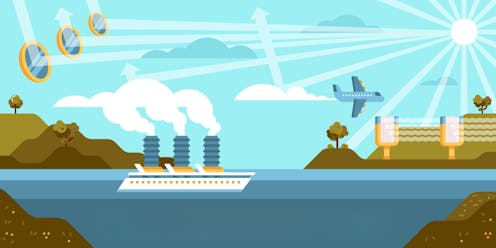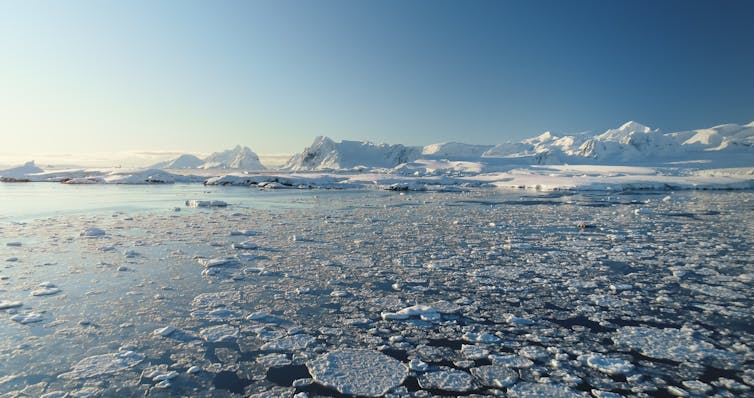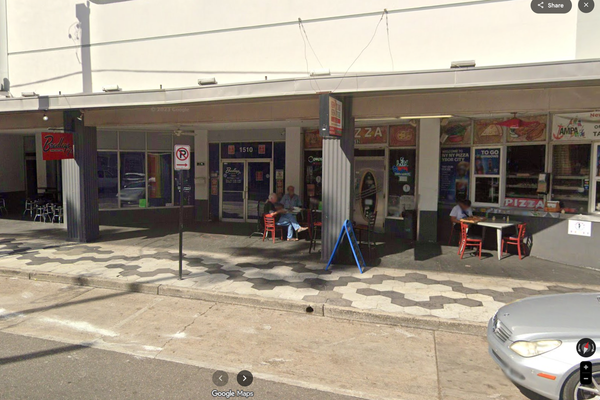
The UK government recently announced plans to fund five small-scale trials related to geoengineering. It’s the first time a state research funding body has put serious money into what’s known as solar radiation management, or SRM, which seeks to cool the planet by reflecting more of the Sun’s energy back into space.
It’s easy to see why countries have been so hesitant to proceed with projects of this nature: SRM is highly controversial, even among scientists.
Deliberately altering the atmosphere, a shared global resource, is fraught with ethical, geopolitical and practical problems. It is and always has been a crazy idea.
However, many consider the failure to control carbon emissions means not intervening in this way is an even crazier idea. They consider it necessary to avert the collapse of ecosystems and society. Perhaps solar geoengineering is the price we must pay for our wholly inadequate climate change response to date.
The good news is that SRM may be able to deliver some progress relatively quickly. Earth has become slightly less reflective over the past few decades. That’s mostly thanks to reduced cloud cover (warmer oceans cause clouds above them to evaporate), but also thanks to less snow and ice, and a significant reduction in nasty-but-reflective shipping fuel pollutants.
By my calculations (based on data from US climate scientist James Hansen), this reduction in the reflectivity of Earth has caused as much warming as the 750 gigatonnes of CO₂ emitted since 2005. And while it will take decades to achieve significant global cooling through decarbonisation, it can be achieved relatively quickly by small increases in reflectivity.
Of the 21 projects being funded by Aria, the UK government’s Advanced Research and Invention Agency, five are likely to involve small-scale outdoor experiments. They account for about half the £57 million programme.
Three of the projects concern brightening clouds over the ocean, one explores a method of refreezing the Arctic and the fifth looks at a specific detail of injecting reflective aerosols into the stratosphere.
The other projects concern how to govern these technologies and model and monitor their effects. They could also yield insights vital for securing the public and governmental support necessary if these technologies are ever to be deployed on a much larger scale.
Marine cloud brightening
Marine cloud brightening seeks to make clouds over the ocean more reflective. This is done by turning seawater into an aerosol spray and allowing air currents to loft salt crystals into the clouds, where they enhance the creation of reflective water droplets.

The greatest challenge with this method is making enough seawater mist in which the droplets are of a uniform size, about 1 micron in diameter. The Reflect project led by the University of Manchester has received £6.1 million to explore “the technical feasibility and optimal methods” for generating these droplets.
A team from the University of Reading has developed a process using drones to fire electric charges through fog to alter the size of its water droplets. Their Brightspark project has been awarded £2 million to determine whether this process would be viable and safe if applied to clouds. A second phase involving small-scale testing in the UK is contingent on further approval by Aria.
Daniel Harrison, an oceanographer at Southern Cross University in Australia, has been researching marine cloud brightening for several years for the limited purpose of protecting the corals of the Great Barrier Reef. Preliminary results are positive.
His previous work will be extended to assess if, and how, marine cloud brightening could work safely and effectively, but still only as a regional intermittent intervention to protect coral from marine heatwaves.
This will also be a two-phase project (£1 million and £5 million respectively) in which the research will initially deal with modelling and spray design. Subject to further approvals, it will then test the newfound knowledge over the Great Barrier Reef.
Read more: Could 'marine cloud brightening' reduce coral bleaching on the Great Barrier Reef?
The remaining two projects are both from teams led by the Centre for Climate Repair at Cambridge University (I’m an associate researcher of the centre but I have no involvement in either of these projects).
Arctic refreezing
Engineer Shaun Fitzgerald has been awarded £9.9 million to extend an existing research project to examine the feasibility of thickening Arctic sea ice by pumping seawater from below the ice on to the surface, where it freezes. The idea is to increase the extent and thickness of sea ice in winter so that it endures longer through the summer.

Read more: Arctic ice is vanishing – our bold experiment is trying to protect it
The project also includes modelling to assess the impact this would have on a range of climate phenomena. Most significantly, this includes the Atlantic meridional overturning circulation, an ocean current that some fear is in imminent danger of weakening sufficiently to bring Siberian winters to north-west Europe.
Stratospheric aerosol injection
The final project being funded looks at the injection of aerosols into the stratosphere – higher than clouds – where they would reflect a little of the Sun’s energy back to space.
Many regard this as the form of geoengineering most likely to happen. It is the most studied, as it replicates the natural cooling effect of certain big volcanic eruptions that put massive amounts of sulphate-based aerosols into the stratosphere. Scaling it to be climatically significant is thought to be relatively straightforward, and would probably be the cheapest cooling option.
One significant concern is the health and environmental impact of these aerosols as they fall back to the planet’s surface. Hugh Hunt, also an engineering professor at Cambridge, has been awarded £5.5 million to examine a range of alternative aerosol compounds. The plan is to send tiny samples into the stratosphere in specially designed gondolas attached to balloons. The gondolas will later be recovered, so that the effect of the stratosphere on the samples can be examined. Nothing will be released into the atmosphere.
A small step towards something much bigger
Aria is treading a fine line with this programme.
On the one hand, the organisation recognises that further interventions might be needed to mitigate the harm from the continuing failure to phase out fossil fuels. On the other, it recognises how controversial such interventions are. It is clearly anxious not to provoke a public furore that could undermine the research effort.
In isolation, it is unlikely that this programme will fill any knowledge gaps that might encourage policymakers to push climate intervention up the international agenda. What it could demonstrate, however, is that with appropriate controls in place, it is safe to test these options.
Perhaps the next funding round will support bigger outdoor experiments. These would help determine which technologies can eventually become the safe and effective climate interventions we desperately need.
Don’t have time to read about climate change as much as you’d like?
Get a weekly roundup in your inbox instead. Every Wednesday, The Conversation’s environment editor writes Imagine, a short email that goes a little deeper into just one climate issue. Join the 45,000+ readers who’ve subscribed so far.
Robert Chris does not work for, consult, own shares in or receive funding from any company or organisation that would benefit from this article, and has disclosed no relevant affiliations beyond their academic appointment.
This article was originally published on The Conversation. Read the original article.







